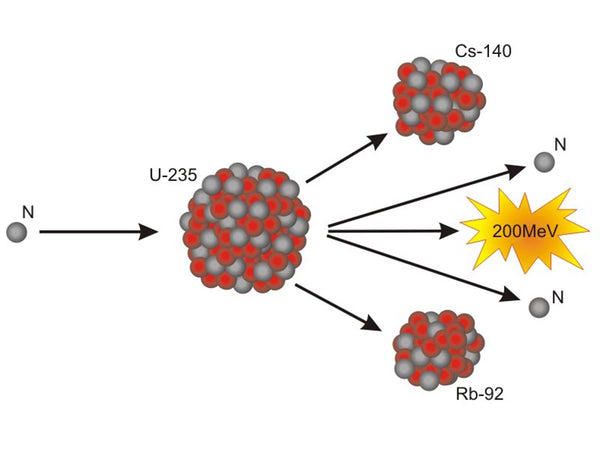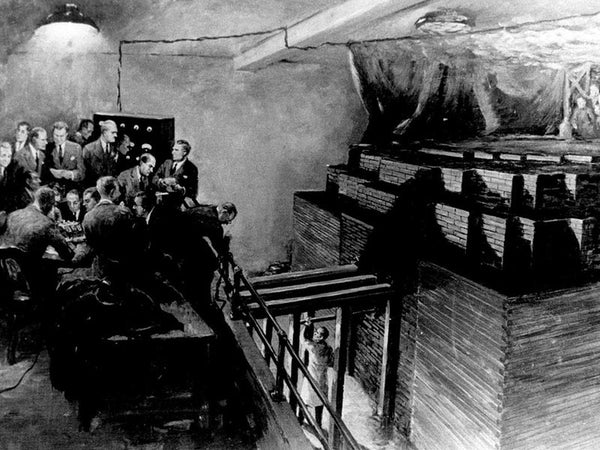In 1972, it was discovered that due to the ingenious arrangement of nature, natural nuclear reactors had appeared in the Gabonese Republic of Africa about 1.8 billion years before the birth of mankind. French scientists were investigating the ore shipped from the Oklo mine in the Gabonese Republic and found that the content of uranium 235 was lower than normal. This attracted their attention because the distribution of uranium is very constant, even if it is mined from the moon. The returned rock samples contained uranium-235 in amounts similar to those on the earth, so they conducted on-site surveys.
They discovered that as far back as 1.8 billion years ago, due to natural coincidence, there were at least six reactors in the Oklo mine that operated intermittently for hundreds of thousands of years, releasing heat equivalent to the burning of more than 20 million tons of coal.
Uranium 235

Uranium is currently the most important nuclear resource. Uranium in nature is called natural uranium. There are three isotopes: uranium 238, accounting for 997%; uranium 234, accounting for 0.06%; and uranium 235 accounting for 0.24%. The nuclear properties of these three isotopes are quite different, and only uranium 235 nuclei are prone to fission.
In 1896, the French scientist Becquerel discovered the natural radioactivity of uranium. Uranium can automatically and continuously emit a kind of very penetrating rays, which can make photos sensitive through black paper. This phenomenon is called radiation. Since the radioactivity of uranium was discovered, nuclear energy and nuclear technology have developed rapidly. After the fission of uranium 235, in addition to generating strong radiation and releasing a large number of neutrons, it also releases a large amount of energy.
In 1939, German scientist Otto Hahn discovered that the element uranium isotope 235U nucleus can undergo nuclear fission and release energy at the same time under the bombardment of neutrons. Many heavy nuclear isotopes, such as 233U and 239Pu, can produce nuclear fission reactions. The energy released by each uranium 235 nuclear fission is very small. It takes more than 130 billion fission times to increase the temperature of gram of water by 10C, and 9.149 million fission times to generate heat equivalent to the combustion of 1 gram of standard coal. But 1 gram of uranium 235 has 5.6 trillion atoms, so the energy released by nuclear fission is very huge. Nuclear fission reactions emit much more energy than chemical reactions, which heralds the prospect of nuclear energy utilization. The 235U nucleus generates fission fragments after fission and releases 2-3 neutrons at the same time. If the newly generated neutrons can bombard other 235U nuclei and cause new nuclear fission, the fission reaction can continue. We will image this process. It is called "chain reaction". Under the continuous chain reaction, nuclear energy is continuously released. In addition to fission such as 235U, which can release nuclear energy, hydrogen isotopes, such as tritium (3H) nuclei, can also polymerize into helium (He) nuclei under certain conditions, and release energy at the same time. This is also a form of nuclear energy. We usually fission nuclear The nuclear energy released by the reaction is called "fission energy", and the nuclear energy released by the nuclear fusion reaction is called "fusion energy".
In the early 1970s, Chinese geologist Professor Hou Defeng and others asserted that the natural chain reaction of uranium-235 had occurred in the world, and believed that the nuclear energy released by various fission and decay was the driving force for the early evolution of the earth’s crust. Therefore, the earth in the past It used to be a world of nuclear power. The various fission reactors built around the world today are nothing but larger-scale and longer-time natural nuclear fission reactions in the universe, including the epitome of the fission reaction that occurred in Oklo 800 million years ago. The basic principles are the same, but As the crystallization of human wisdom, current nuclear energy is much more detailed and precise than nuclear technology.
Nuclear fission

In December 1941, at the suggestion of Einstein and other scientists, US President Roosevelt approved a plan called the "Manhattan Project" to develop an atomic bomb before Hitler. In March 1941, Sibourg bombarded uranyl sulfate with neutrons to produce trace amounts of plutonium 239. Lawrence discovered the fission of plutonium 239, so American scientists considered building 30 subcritical devices with natural uranium to study the realization of chain reactions. And control the conditions of the scale of this reaction.
After a large number of experiments for more than a year, by July 1942, scientists had believed that they had the ability to design a reactor that could realize chain reaction and control it. In November, Italian physicist Enrico Fermi led the construction of the first reactor at the University of Chicago. The University of Chicago is located in a densely populated area, and its bold decision to build the first reactor here is eye-catching.
They built the reactor in a corner under the stands of an abandoned football stadium at the University of Chicago. It was made up of layers of graphite bricks and metal uranium blocks. Fermi and others designed a wooden frame grid, and then placed layers of graphite bricks on it, and put uranium or uranium oxide blocks between the same ones, because Fermi obtained insufficient pure uranium metal at that time. In this way, the layers overlap from bottom to top, and the outermost layer uses a graphite layer with a thickness of 30 cm as a reflective layer to prevent neutron leakage. They shared 40 tons of natural uranium nuclear fuel, 293 tons of graphite moderator, and 92 tons of reflective layer graphite used to reflect neutrons. Only then did they create a 7.47-meter-square-foot, 5.8-meter-high reactor with cadmium and other materials inserted in the middle. Great.
The experiment of mankind's first self-controlled reactor went smoothly. Although it only worked for 28 minutes, it was an epoch-making event. It marked the entry of mankind into the era of nuclear energy and opened up broad prospects for mankind to develop and utilize nuclear energy. Although the power of the first reactor was only 2,000 watts, which was less than one-millionth of the thermal power of the current largest reactor, it finally opened up a new era in human history.
Scientists estimate that with the current scale of energy utilization, only the fusion nuclides in the ocean can be used by humans for tens of thousands of years, which will completely solve the human energy problem. However, human beings are still far away from achieving controllable nuclear fusion, especially reaching commercial levels. Therefore, the current peaceful use of nuclear energy is mainly the use of fission energy.
Nuclear energy development process

Nuclear energy is a great invention in human history, which is inseparable from the exploration and discovery of early Western scientists, who laid the foundation for the application of nuclear energy. We summarize the entire discovery and development process of nuclear energy as follows:
At the end of the 19th century, British physicist Thomson discovered electrons.
In 1895, the German physicist Roentgen discovered X-rays.
In 1896, the French physicist Becquerel discovered radioactivity.
In 1898, Mrs. Curie and Mr. Curie discovered a new radioactive element polonium.
In 1902, Madame Curie discovered the radioactive element radium after four years of hard work.
In 1905, Einstein proposed the mass-energy conversion formula.
In 1914, British physicist Rutherford determined through experiments that the hydrogen nucleus is a positively charged unit called a proton.
In 1935, British physicist Chadwick discovered the neutron.
In 1938, German scientist Otto Hahn bombarded uranium nuclei with neutrons and discovered nuclear fission.
On December 2, 1942, the University of Chicago successfully launched the world's first nuclear reactor.
On August 6th and 9th, 1945, the United States dropped two atomic bombs on Hiroshima and Nagasaki, Japan.
In 1957, the Soviet Union built the world's first nuclear power plant-Oblingsk Nuclear Power Plant.
During World War II, with the birth of the atomic bomb. Mankind began to apply nuclear energy to military energy, industry, aerospace and other fields. The United States, Russia, Britain, France, China, Japan, Israel and other countries have successively launched studies on the prospects of nuclear energy applications.